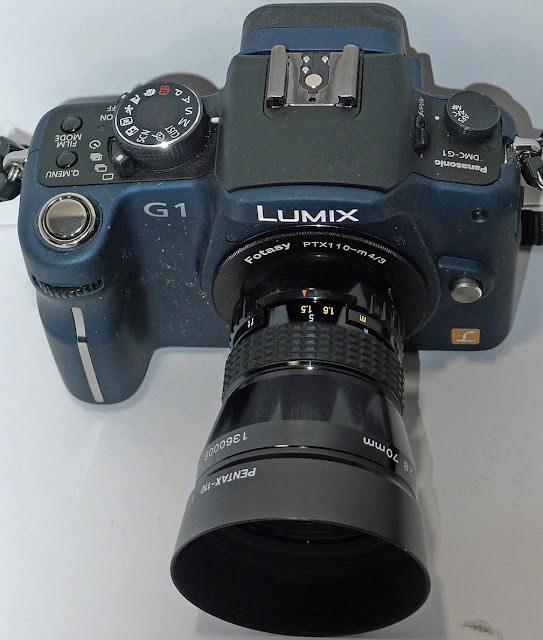March 16, 2018
#242
Gentle reader,
I have rarely seen the improved version of by far the smallest Single Lens Reflex camera made by Pentax and called the AUTO 110. I've owned an number of them over the years and not so long ago bought a complete system kit. They made a larger more complete system called SYSTEM 10 which included rubber lens hoods for the three lenses, as well as filters and close-up lenses too. One kit came in an aluminum briefcase. The "10" came in a larger cardboard box similar to these.
While the boxes are the same size, the markings are different. Note "ASAHI" is missing from the SUPER box and PENTAX now has a copyright symbol next to it.
This is what I saw when opening this kit which I scored for only $70. The seller stated that it appeared the camera, etcetera had not been used. My examination showed that they all had been used and sadly, the flash and winder had suffered battery corrosion and despite my best efforts, they remained dead. The case appears to be suede, but may be synthetic. The original soft case was vinyl. Strap is still sealed in plastic. All lens caps and viewfinder cap are still here as is the flash case.
This is the older original kit. As you can see, the fabric has aged. Speaking of aged, according to my 1999 ORION CAMERA BLUE BOOK, the original AUTO 110 came out in 1979 and was made through 1983. They are listed under: Instamatic. Two years later (1985) the SUPER model came out for the same price of $180 for the camera and 24mm lens alone. No information on the cost of the various system kits they sold. Oddly, looking through the book, I find the AUTO 110 SUPER also listed under Subminiature and coming out in 1995, I believe that to be a typo. Here, they listed the Super body alone as selling for $201.
Further searching shows the 20-40mm Zoom lens sold new for $180. The 50mm for $90. The 24mm for $60. The 18mm pan focus for $60 also, I don't see the wide angle 18mm listed. The 70mm telephoto listed for $100. The AF130P flash retailed for $55. No listings for the smaller flash.
Below, the body changes are detailed in the photos and text.
Most obvious are the height and labels.
Super model's lever is taller and longer.
Super model's top is stepped and surrounds the shutter button.
Main difference is the Super model has a three-way switch that surrounds the winding lever. Settings are: Locked, Auto, Self-timer. Standard model had no way to turn the camera on and off. Perhaps the winding lever did so?
There is a collar around the flash terminals on the Super. It stabilizes the flash which tends to wobble on the standard body. The little tab device in front of the collar is used to lift the plastic cover for the flash terminals.
RED LED serves as a flashing timer during self timer countdown. And is the most visible clue to it being a Super body. Note, that "ASAHI" is no longer on the face on the Super.
Above is a button that is used for exposure compensation. Say your subject is backlit, press the button and the meter compensates by setting exposure for the subject rather than the brightness behind.
No changes to the bottom. The Winder is now a Winder II. As I noted above, it does not work. I'll be on the lookout for one of those too.
Since I have no written information yet on the SUPER, I can offer no other words as to the differences between the two. It seems Pentax (less ASAHI) was hoping to rekindle interest in their wee camera by updating it and yet keeping the retail price the same as the old model. Based upon their rarity, not many fold ponied up to buy one.
Once again, thanks for looking!
Scott
March 16, 2018



























































